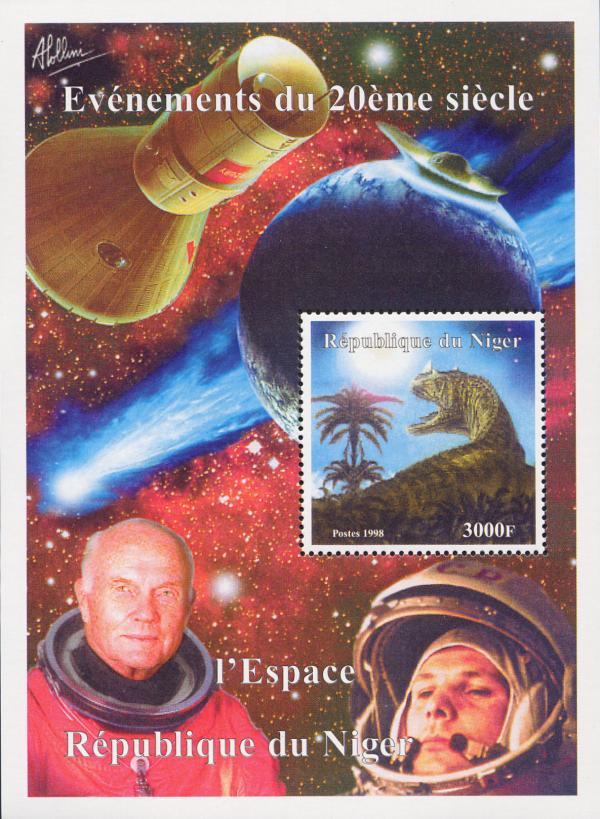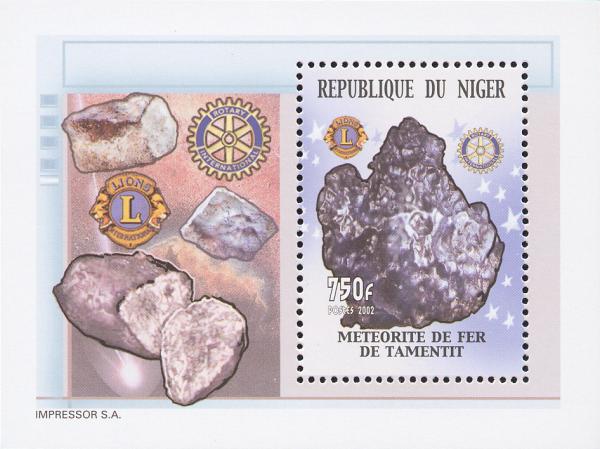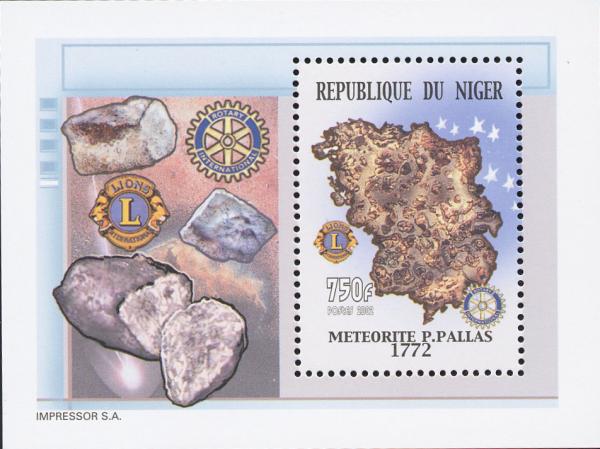
Niger

Denominazione ufficiale: Repubblica del Niger
Official name: Republic of Niger
Nome nella lingua originale: République du Niger (francese) - Jamhuriyar Nijar (Hausa)
Superficie: 1.267.000 km²
Popolazione: 10.075.511 ab.
Appartenenza: Stato sovrano
Capitale: Niamey
Moneta: Franco CFA
Lingue ufficiali: Francese
Nascita: Indipendenza dalla Francia, 3 agosto 1960
Area: Africa
Fuso orario: UTC +1
Prima emissione: 1959
Ultima emissione: Attuale
Per saperne di più: http://it.wikipedia.org/wiki/Niger

Soggetto: space-related events of the twentieth century Anno: 1998 Notizie: In 1998 the Republic of Niger nominally issued a souvenir sheet commemorating space-related events of the twentieth century. This sheet shows a giant impactor striking the earth, a comet (possibly Halley's Comet), astronaut John Glenn, cosmonaut Yuri Gagarin, and a Mercury space capsule. The embedded stamp depicts a dinosaur watching a giant impactor's fireball as it penetrates the Earth's atmosphere. The Scott 2003 catalog indicates this sheet was not authorized by the Niger postal authorities. It is not a legitimate issue. Gagarin, the "Columbus of the Cosmosm," became the first human in space and the first to orbit the Earth. On April 12, 1961 he completed a single orbit of the Earth in the Vostok 1 space capsule. Glenn was the first American to orbit the Earth. He completed three orbits in a Mercury capsule called the Friendship 7 on February 20, 1962. In October 1998 Glenn became the oldest person so far to travel in space, as a member of the crew of the space shuttle Discovery . The impact depicted on this sheet possibly represents that at the end of the Cretaceous which may have caused the extinction of the dinosaurs. If so, the impactor is drawn far too large. The end-Cretaceous impactor was probably about ten to twelve kilometers in diameter. The impactor shown on the sheet appears to be several hundred kilometers in diameter. The Earth has not been struck by an object of this size since very early in its history. |
|---|

Soggetto: the iron meteorite Tamentit Anno: 2002 Notizie: The second stamp depicts the iron meteorite Tamentit. This meteorite was first reported in the West in 1865. It was found in Tamentit Oasis in the district of Touat in Algeria. It may have fallen near the end of the fourteenth century. The local Arabs venerated the meteorite and considered it their talisman. The main 510 kg mass now resides in the Muséum National d'Histoire Naturelle in Paris, France. |
|---|

Soggetto: the meteorite Bouvante Anno: 2002 Notizie: The third stamp depicts the meteorite Bouvante which was found July 30, 1978 in Drome, France. Bouvante is classified as a "Stannern Trend" Eucrite achondrite. This means it may be a fragment of the asteroid Vesta. |
|---|

Soggetto: the Pallas meteorite Anno: 2002 Notizie: The first stamp depicts the Pallas meteorite, commonly known as Krasnojarsk among meteorite collectors. The Pallas meteorite is sometimes called the "foundation stone" of meteoritics since analysis of its chemical composition afforded a basis for those claiming meteorites had an extraterrestrial origin. The Pallas stone was found by a retired Cossack named Yakov Medvedev around 1749. Around 1771 or 1772 the stone came to the attention of the naturalist Pyotr Simon Pallas. Pallas, after whom the stone would later be named, was a German who conducted a wide spectrum of scientific investigations in Siberia under the aegis of the Tsar's Academy of Sciences in St. Petersburg. At that most academics dismissed the idea of stones falling from the sky, and Pallas was no different, although he recognized that the Pallas stone was definitely something unusual. Samples of the strange stone were sent to labs all over Europe. In 1776 the German chemist E. K. F. Meyer performed a chemical analysis of a sample of the Pallas stone and showed that it could not have had a human or volcanic origin. In 1794 Ernst Chladni, a German physicist, listed the Pallas stone as an example of a stone with an extraterrestrial origin. However, it was the English chemist Edward Howard and his French colleague Jacques-Louis Compte de Bournon who in 1802 first showed the basic similarities in composition among several different meteorites from different locations, including the Pallas stone. All of the meteorites contained nickel, not an element typically found in terrestrial rocks. The analyses of Howard and Compte de Bournon, among others, helped convince most scientists that stones really did fall from the sky, and that they did not originate on Earth. Meteorites with a composition similar to the Pallas stone are now called "Pallasites." Pallasites are composed of olivine crystals set in a nickel-iron matrix. They probably formed in the boundary layer between the iron core and the stony mantle of an asteroid. Thin translucent slices of well-preserved Pallasites are very attractive and are used to create jewelry. Roy A. Gallant provides an in-depth look at the importance of the Pallas stone in his article A Man Named Bear and His Meteorite: The Fall and Rise of the Pallas Nugget . |
|---|